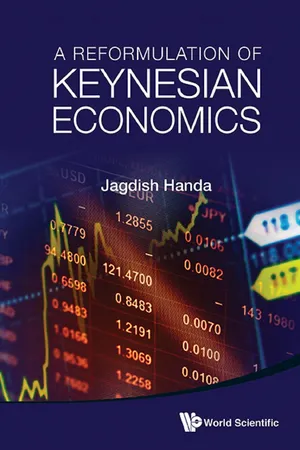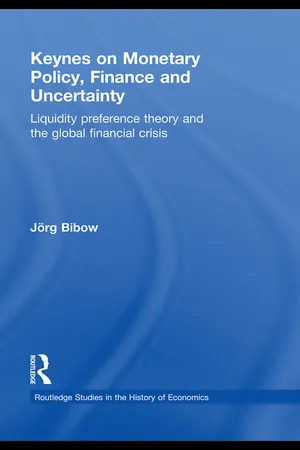Economics
Loanable Funds Market
The loanable funds market is a theoretical market where savers supply funds and borrowers demand funds. The interest rate is the price that balances the supply and demand for loanable funds.
Written by Perlego with AI-assistance
Related key terms
4 Key excerpts on "Loanable Funds Market"
- eBook - ePub
The Macroeconomic Environment of Business
Core Concepts and Curious Connections
- Maurice D Levi(Author)
- 2014(Publication Date)
- WSPC(Publisher)
CHAPTER 7 INTEREST RATES“Gentlemen prefer bonds”Andrew MellonKey Concepts: Interest rates and the supply of loanable funds; interest rates and the demand for loanable funds; the equilibrium interest rate; the market versus equilibrium interest rate; monetary policy and interest rates; real growth and interest rates; anticipated inflation and interest rates; real versus nominal interest rates; fiscal deficits, crowding-out and interest rates; international capital flows and interest rates.THE INTEREST IN INTEREST RATESInterest rates have a substantial effect on borrowing and spending decisions of businesses and consumers, and thereby on employment, GDP, and other measures of macroeconomic activity. For example, as we shall see, interest rates influence the willingness of businesses to invest in new plant and equipment, and in turn, the current and future size of the GDP.At the same time that interest rates affect the economy, the economy affects interest rates. This occurs as a result of the effects that national income, inflation and confidence about the future have on the willingness of consumers and businesses to borrow and invest, and hence on the price of borrowing, which is the interest rate. With the direction of flow being in both directions, from interest rates to the economy and from the economy to interest rates, in order to explain interest rates we need a theory that captures this two-way flow of influence. Such a theory is the loanable funds theory. While there are numerous other theories of interest rates, the loanable funds theory embraces many aspects of these other theories, and therefore serves as an ideal window onto the world of interest rates.LOANABLE FUNDS THEORY OF INTERESTAccording to the loanable funds theory, interest rates are determined by the supply of and demand for loanable funds, which can be thought of as monies that can be lent and borrowed. Therefore, in order to explain this theory, we must begin by considering loanable funds supply and demand. - eBook - ePub
Maximum Government, Maximum Governance
Reframing India's Macroeconomic Discourse
- Sashi Sivramkrishna(Author)
- 2019(Publication Date)
- Routledge(Publisher)
- The classical economists saw the market system as working efficiently in clearing markets through the price mechanism. This is true not only in the goods market but also in labour markets as well as the Loanable Funds Market. State interventions or other imperfections (trade unions) cause distortions, which do not allow markets to clear.
- Economic policy should be directed at unshackling the economy of supply-side constraints. Once this is done, by Say’s Law, supply will create its own demand. Temporary excess demand in any market/s will be matched by an excess supply in other market/s. Price changes will take the economy back to general equilibrium, i.e. where all markets clear. This is a continuous process, which is best left to the market system.
- In the classical model, money acts as a mere medium of exchange—for present or future exchange of real goods—or in more technical language, money is neutral. Economists look beneath the veil of money to ascertain real exchanges in the market.
- According to classical loanable funds model banks and other financial institutions act as financial intermediaries that channellize loanable funds from savers (primarily households) to investors (primarily firms). These intermediaries bring in economies of scale and overcome information asymmetry, which otherwise make it difficult for savers to find suitable investors. The notion of banks as financial intermediaries has important implications for mainstream macroeconomic modelling—since banks and credit are nothing but a conduit for transfer of funds from savers to borrowers there is no net effect of such transactions on the economy;15 banking and credit can then be safely left out of the analysis.
- Household savings are the main source of loanable funds which firms must use to finance their investment plans. An increase in the savings rate (shift in the savings curve) will bring down interest rates and increase the quantity of loanable funds invested. Private-sector investment is therefore considered savings constrained. The only other source of loanable funds is foreign capital inflows. By basic balance of payments (BoP) accounting, such capital inflows automatically imply a current account deficit.
- eBook - ePub
- Jagdish Handa(Author)
- 2015(Publication Date)
- WSPC(Publisher)
The existence of quantity rationing raises the obvious question: assuming that the market in question does not have price rigidities and is efficient, why does the interest rate not rise by enough to clear the market? Part of the reason for this lies in the potential for moral hazard and adverse selection. They imply that a rise in the interest rate may cause borrowers to pursue more risky projects and for the composition of borrowers to change. On the latter, at higher interest rates, borrowers with less risky projects (and lower expected returns) are more likely to drop out of the market (i.e., not borrow) while leaving in the market more risky borrowers still willing to borrow. As a consequence, the higher interest rate may be accompanied by a shift to more risky borrowers and projects, and a higher risk in lending. Over all borrowers, these considerations yield the economy’s constraint over the expected yield and the risk, with a trade-off between the two.Therefore, at the level of the economy as a whole, the supply of financial capital to borrowers will be rationed through the interest rate charged, as well as by the quantity made available. The amount that is finally lent will depend on the performance of the various sectors and of the economy. To illustrate, the amount lent is likely to increase in upturns relative to that in downturns in the commodity market, as well as in the markets for assets. Further, the overall amount of financial capital in the economy will be affected by the availability of funds to the lenders themselves, as illustrated by the case of banks discussed in the next section.6.5 Banks as Providers of Financial Capital
One of the providers of financial capital to the economy is commercial banks. Besides being holders of the public’s deposits, banks provide loans to the public, so that they are also providers of financial capital, especially credit. Our concern in this chapter is mainly with financial capital and the latter role of the banks, rather than with the banks’ role as takers of deposits and creators of money. On the latter, the literature provides extensive treatment of the determination of the money supply and its dependence on the monetary base (see Handa, 2009, Chapter 10), so that this chapter examines only the creation of financial capital by banks. - Jorg Bibow(Author)
- 2013(Publication Date)
- Routledge(Publisher)
Perhaps it is no surprise that neo-Walrasian general equilibrium theorists have never been able to settle the LP– LF issue, an issue which concerns disequilibrium adjustments in intertemporal prices. At any rate, the loanable funds fallacy poses a formidable challenge to neo-Walrasians: to justify the idea that – by some mechanism other than the elegant Walrasian fiction – intertemporal prices correctly reflect technology and time preferences. 3.7 Filling the gap – the liquidity preference theory of interest The main message of this chapter is a negative one: the loanable funds mechanism which loanable funds theorists believe to directly and immediately lower interest rates when a rise in thrift occurs was shown to be a mere mirage. Keynes’ analysis in the Treatise already establishes the logical inconsistency of what went on to become loanable funds theory, a result which we corroborated in Section 3.3 by means of a generalized financial buffers approach. However, it was not until a few years later that Keynes himself completed his alternative vision of the process of capital accumulation in monetary production economies. In The General Theory, the principle of effective demand is shown to be the key to the level of economic activity at any time, while the rate of interest – one determinant of effective demand – is “determined exogenously with respect to the income generation process” (Pasinetti 1974: 47). In particular, interest rates are determined independently of the real forces of productivity and thrift believed to be the anchor and steering forces behind the Loanable Funds Market. No doubt, Keynes’ vision of capital accumulation is diametrically opposed to the loanable funds one. Starting from an older vision of capital accumulation in corn economies, with a real saving fund as the classical source of investment “finance,” loanable funds theorists merely annex hoarding and banks, i.e. monetary factors, to the usual corn economy picture
Index pages curate the most relevant extracts from our library of academic textbooks. They’ve been created using an in-house natural language model (NLM), each adding context and meaning to key research topics.



